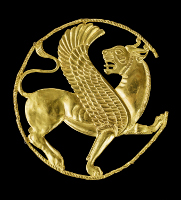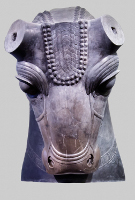A major portion of the Oriental Institute's important collection of Iranian objects comes from its own excavations. Prehistoric materials are particularly well represented as the result of three seasons of work begun in 1932 at the site of Tall-i-Bakun in the plain of Persepolis and twelve seasons in the 1960's and 1970's at Chogha Mish in modern Khuzestan. The museum houses a rich collection of Achaemenid art - including monumental architectural sculptures - that were obtained as divisions of finds after Oriental Institute excavations at Persepolis in the 1930's. A broad chronological and typological range of artifacts discovered by the Holmes Luristan Expedition (1934-38), Luristan and Amlash bronzes purchased on the art market, and items bought from the personal collection of Ernst Herzfeld, who began the Institute's Persepolis excavations, form important complements to the prehistoric and Achaemenid materials.
Persian Roundel
This snarling winged lion worked in gold repoussé attests to the exceptional skill of Achaemenid goldsmiths. The back of the horned feline's body and the slender twisted cord that surrounds it bear sixteen tiny loops for attachment to a garment or textile. Greek writers often speak of the tremendous wealth of the Persians, and Herodotus writes that King Xerxes' troops "were adorned with the greatest magnificence...they glittered all over with gold, vast quantitites of which they wore about their persons" (vii.83).
Beaker with Geometric Designs and Birds
Archaeologists working in Iran at the site of Tepe Giyan during 1931 and 1932 excavated 119 burials dating to five successive periods. Among the vessels characteristic of the Giyan II Period were ones whose decoration combined geometric patterns with representations of small suns and birds. This beaker, acquired by the archaeologist Ernst Herzfeld prior to the 1930's excavations, thus can be dated by its decoration to Giyan II.
Painted Jar
This handmade vessel has a lozenge pattern on the shoulder painted in black on a plum-red burnished surface. This type of ware and decoration are characteristic of a phase in the development of Iranian civilization on the central plateau that is often called "Cheshmeh Ali" after a site of that name near Tehran.
Colossal Bull Head
Carved in the court style typical of the Achaemenid Empire, this highly polished stone head originally belonged to one of two guardian bulls flanking the portico of the hundred-columned Throne Hall at Persepolis. The heads of the bulls projected in the round and the bodies were carved in relief on the sidewalls of the porch; the ears and horns had been added separately. The use of pairs of guardian figures such as these to protect important buildings was a common architectural feature in the ancient Near East.
Frieze of Striding Lions
 An Achaemenid artisan carved this piece of stone to represent part of a cloth canopy that was decorated with woven or appliquéd figures of rosettes and striding lions. Remnants of crenellations on the top of the block indicate that it belonged to the uppermost row of stones. The fringe along the lower edge, representing knotted cords ending in tassels, was partly chipped away in ancient times, perhaps before the stone was reused in the balustrade of a small stairway east of Darius' residential palace.
An Achaemenid artisan carved this piece of stone to represent part of a cloth canopy that was decorated with woven or appliquéd figures of rosettes and striding lions. Remnants of crenellations on the top of the block indicate that it belonged to the uppermost row of stones. The fringe along the lower edge, representing knotted cords ending in tassels, was partly chipped away in ancient times, perhaps before the stone was reused in the balustrade of a small stairway east of Darius' residential palace.
A pair of diamonds joined as a figure-eight can be seen in three places on the face of this stone. They are the marks of the sculptor or team of sculptors who carved this and numerous other Persepolis reliefs on which the same marks appear.
Foundation Slab of Xerxes
 This stone tablet inscribed with Babylonian cuneiform characters lists the nations under Persian rule shortly after the uprisings that occurred when Xerxes came to the throne. Although the tablet was intended as a foundation deposit to be placed beneath a corner of one of Xerxes' buildings, it apparently was never used. It was found, along with other tablets bearing the same text in Old Persian and Elamite, employed as the facing of a mud brick bench in the garrison quarters at Persepolis.
This stone tablet inscribed with Babylonian cuneiform characters lists the nations under Persian rule shortly after the uprisings that occurred when Xerxes came to the throne. Although the tablet was intended as a foundation deposit to be placed beneath a corner of one of Xerxes' buildings, it apparently was never used. It was found, along with other tablets bearing the same text in Old Persian and Elamite, employed as the facing of a mud brick bench in the garrison quarters at Persepolis.
Krater with Ibexes
The geographical term "Susiana," referring to the area ruled in the historical period by the city of Susa, is also applied to the prehistoric cultures of lowland southwestern Iran. Representational designs such as the stylized wild goats with long sweeping horns painted beneath the rim of this krater are characteristic for an advanced stage of the Susiana sequence.
Painted Bowl
Many of the pottery vessels from the site of Tall-i-Bakun in the plain of Persepolis show a highly sophisticated use of negative designs in conjunction with more usual painted patterns. On this bowl, two patterns alternate in rhythmic sequence. One is a painted design of anthropomorphic inspiration with a "head" flanked by upraised "arms" facing both the rim and base of the bowl. The other pattern, which is given in negative by the buff surface of the vessel, consists of a cross and two lozenges.
Disc-Headed Pin
Large numbers of decorated disc-headed pins were found in the sanctuary at Surkh Dum-i-Luri. They may have been votive offerings to a fertility goddess or, on analogy with a modern ethnographic parallel, deposits verifying wedding contracts among nomadic peoples moving through the area. The decoration of this example, with an eight-petaled central rosette and surrounding borders of smaller rosettes and punctate patterns, is typical. The tiny incised lion's (?) head faces away from the shaft because the pins were worn with the head hanging down and the shaft pointing up.
Spouted Gray-Ware Pitcher
Around 1200 B.C. monochrome wares were introduced in many parts of Iran and replaced the earlier painted pottery. These new, frequently burnished, wares occur in both a reddish-orange and a dark gray variety. The gray wares, of which this long-spouted pitcher is a characteristic example, were given their color by special firing in an oxygen-reducing atmosphere. They appear to have been ceramic imitations of metal vessels.









